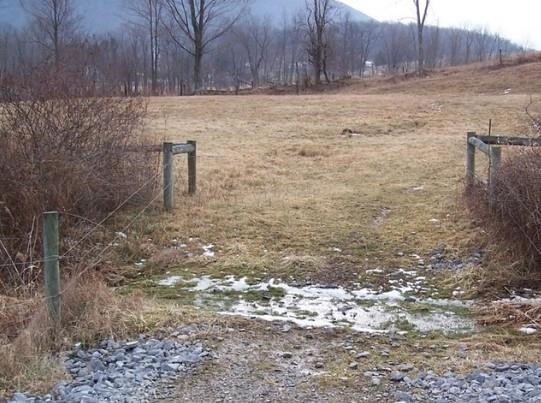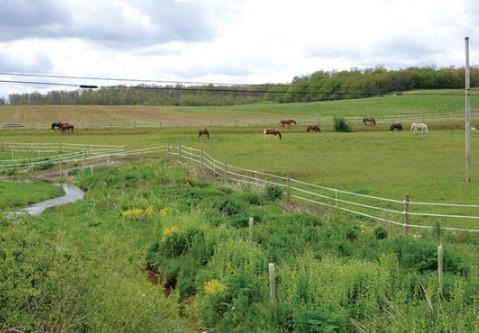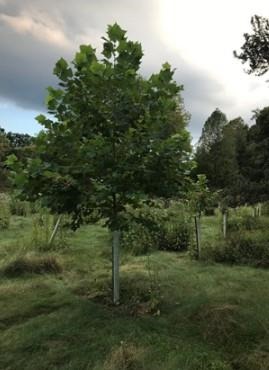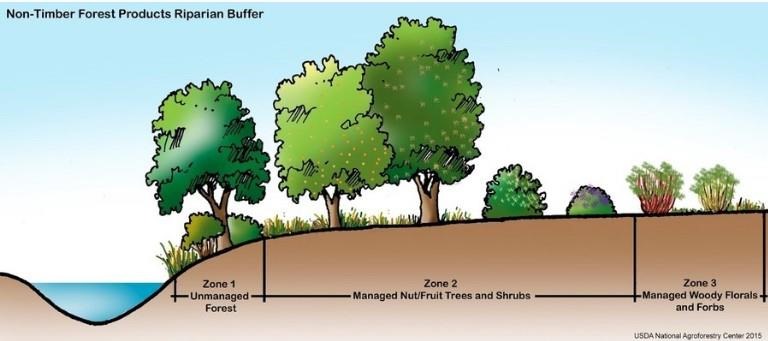By Leanna Duppstadt and Danielle Rhea
There can sometimes be a stigma surrounding the implementation of riparian buffers from an agricultural perspective because of the initial cost, potential maintenance, possible reduction in land area available for cropping systems or pasture, and loss of a water source for livestock. While these concerns are understandable, this article aims to address many of them and to help provide a variety of options and considerations to think about.
The word riparian refers to the area alongside a stream, river, or other body of water. The riparian area becomes a riparian buffer when it is planted with trees, shrubs, meadow plants, or other perennial vegetation instead of being farmed up to the creek edge. This planted perennial vegetation can now buffer the stream; that is, it lessens the impact of nearby land uses by increasing infiltration, filtering runoff, and capturing sediment, nutrients, or other pollutants. Riparian buffers, from an agronomic perspective, serve as a way to prevent erosion while also intercepting sediment, nutrients, and pesticides before they enter a body of water. With livestock, buffers help to prevent streambank erosion from livestock traffic, serve as nutrient interceptors, and prevent the introduction of fecal bacteria and parasites to water sources. Riparian buffers are touted as one of the best ways to protect and improve streams, but the benefits are much greater than water quality alone. From a practical standpoint, installing riparian buffers can straighten field edges that are bordered by naturally meandering streams. Establishing streamside buffers is also linked to reduced property loss, less downstream flooding, and improved wildlife and pollinator habitat.
With the increasing adoption of no-till or minimum tillage, cover crop utilization, and leaving behind more crop residue, Pennsylvania has made great strides in improving soil infiltration and reducing surface runoff. This is our main source of sediment and sediment-associated pollutants, such as nitrogen, phosphorus, bacteria and some pesticides, that enter our waterways. Some pollutants will move via the groundwater, such as nitrates and atrazine. Installing riparian buffers along fields for row crops, hay fields, and pastures can further help to prevent these surface and ground water pollutants from entering neighboring water sources.
Often there is concern with taking land out of crop production and converting it to a riparian buffer because it is seen as a loss of productive land. However, since riparian areas are located beside waterways in low lying areas, they are often subject to periodic flooding and have a shallow depth to the water table. Flooded or saturated soils can negatively affect agronomic yields by making it more difficult to get equipment in the field at the right time, poor establishment or germination and by stressing plants which can reduce vigor or increase susceptibility to diseases. While many agronomic species are sensitive to flooding or saturation, numerous native riparian species are adapted to or prefer these conditions. A study by Pywell et al (2015) found that converting lower yielding field edges to a buffer of species favored by pollinators and wildlife resulted in no net loss of yield in a five-year crop rotation since the overall productivity per acre was increased. The increase in crop yield primarily resulted from increased pollination of insect-pollinated crops along with an increased abundance of crop pest predators.
Nutrients.
Where manure is applied, there are regulations on applying around environmentally sensitive areas. Pennsylvania manure application setback requirements call for at least 100 feet between surface waters such as streams, lakes, and ponds. However, this setback may be reduced to 35 feet with a permanent vegetative buffer, giving producers more land area to spread manure. Manure application rates should always be based on nutrient needs to prevent the addition of excess nutrients that are subject to runoff or leaching.
In pasture settings, implementing a managed grazing system or maintaining a dense vegetation throughout the growing season of at least 3 inches is necessary. The addition of a riparian buffer with fencing (Figure 1) surrounding it would be a practical way to comply with manure management plans because livestock would be unable to heavily graze the buffer strip. Fencing also keeps animals and their manure out of streams, which contributes bacteria, nitrogen, and phosphorus to the water. Allocating designated crossing areas or access points (Figure 2) will allow for livestock to safely travel across streams or have access to clean drinking water while also limiting the amount of time they spend wading in the water and degrading marginally grazed areas of the streambank. Reinforced crossings can also help to decrease mud along streams and remove the potential for animals crossing at steep or rocky areas.

Figure 1: Streambank fencing with riparian buffer on left and pasture on right. Credit: Jeff Vanuga, USDA Natural Resources Conservation Service

Figure 2: Designated stream crossing for livestock. Credit: Melanie Barkley, Penn State Extension
Excess nutrients in water can also occur with the application of commercial fertilizers. In combination with proper nutrient management techniques, riparian buffers can absorb and filter out nutrients before they reach a body of water. These nutrient management considerations are especially important in the Chesapeake Bay watershed, of which stream bank fencing, riparian buffers, erosion control, and nutrient management are key conservation practices. County conservation district personnel are a great resource to turn to for environmental questions.
Pesticides.
Pesticides with properties that could impact surface and/or ground water will have label advisories designed to protect water resources. These may be general advisories or specific requirements regarding the pesticide’s use, such as requiring setbacks or buffers. Surface and/or groundwater advisories will be found under the Environmental Hazards section of the product label. The requirements for setbacks and buffers are typically found under this section of the label but could also be found under the Precautions and Restrictions section of the Directions for Use.
As an example, products containing the active ingredient atrazine require a setback of 66 feet between application points and streams or rivers and up to 200 feet from natural lakes; among others including mixing and loading restrictions near water. Other products will have a more general advisory regarding surface and/or ground water. For example, many pesticide products that have surface and groundwater concerns, including those containing the active ingredient 2,4-D, will have the following statements – "Do not apply directly to water, to areas where surface water is present, or to intertidal areas below the mean high-water mark. Drift and runoff may be hazardous to aquatic organisms in water adjacent to treated areas. Do not contaminate water when disposing of equipment wash waters or rinsate. This chemical has properties and characteristics associated with chemicals detected in groundwater. The use of this chemical in areas where soil is permeable, particularly where the water table is shallow, may result in groundwater contamination." By having natural buffer zones, and following pesticide label directions, we further decrease the chances of agricultural products impacting water resources.
Thinking about buffer design.
Riparian buffers can be designed in a variety of ways and contain diverse kinds of plants including grasses, shrubs, trees, or other vegetation. The fundamental idea behind establishing a riparian buffer is, regardless of which plants are chosen, that they are perennial and will live for many years and naturally repopulate over time. It is also widely recommended that the chosen plants are native to the region that you live. Native plants are adapted to the climate and soils of a designated region, grow better, and are easier to maintain than ornamental species. While native plants are best suited for their native ecosystems, they are also less likely to grow to invasive levels. Additionally, they provide better habitat and food sources for wildlife, pollinators, and aquatic species, which have also adapted alongside our native plants. Luckily, there is a multitude of native perennial plants that thrive in riparian areas. Broadly, riparian buffers can be classified into two major categories: herbaceous buffers, which contain non-woody plants like grasses and wildflowers, and forested buffers, which contain woody plants like trees and shrubs. Either type of buffer will provide benefits; however, herbaceous and forested riparian buffers do not function in exactly the same way and one or the other may be preferred depending on landowner goals.
Herbaceous buffers are commonly used along small streams that flow through crop fields and pastures (Figure 3). These buffers can be installed either by letting existing vegetation grow or by planting a specific riparian seed mix that could include a variety of grasses, wildflowers, sedges, ferns, or other non-woody plants. Native species are best suited for this and may require occasional maintenance to re-establish thinning stands or control undesired species. It is crucial to make sure there is dense vegetation coverage in the buffer in order to prevent any concentrated flow paths from field to stream. Maintenance of these buffers is focused on preventing or controlling invasive species and could include periodic mowing or targeted herbicide application. Herbaceous riparian buffers are very effective at slowing and dispersing water runoff. Tall grass and other vegetation slows the flow of runoff and increases infiltration, acting as a filter so that the sediment, along with anything being carried by the sediment, will settle out before reaching the stream. Herbaceous riparian buffers may be preferred in situations where shade of nearby fields or leaf litter are a concern; however, these non-woody species are not as effective at preventing stream bank erosion and non-forested streams are typically narrower and faster flowing, migrate more quickly, and provide less benefits when compared to forested buffers.

Figure 3: A mostly herbaceous buffer with streambank fencing. Credit: Robb Meinen, Penn State Extension
Forested buffers include a mixture of woody plants, predominantly trees and shrubs. As already mentioned, native species are best suited for buffers and plants should be chosen based on site characteristics such as the soils, frequency of flooding, and available light. Additionally, landowner goals and preferences should also be considered when selecting species. Generally, young, bare root or containerized seedlings are planted 10-15 feet apart (approximately 200-435 trees per acre) and if 70% of the plants survive, the planting is considered successful. Maintenance of forested riparian buffers is also focused on invasive species control and ensuring plant survival. Commonly, tree shelters or wire cages will be placed around newly planted stock to protect plants from deer browse. Occasional mowing and targeted herbicide applications may also be used as needed to control undesirable plants. In addition to improving aquatic ecosystems, forested riparian buffers are also very effective at stabilizing streambanks, increasing infiltration rates and water holding capacities of soils, mitigating flooding, and accessing and utilizing nitrate-nitrogen in shallow groundwater. As trees mature, they can also provide shade or act as a windbreak, which may be a benefit for livestock on pasture (Figure 4).

Figure 4: A mature tree growing in a buffer/tree tube which can provide stability to streambanks and shade for livestock. Credit: Danielle Rhea, Penn State
The three-zone approach for buffer design, combines both herbaceous and woody plants to create an even more effective buffer. Zone 1, designated undisturbed forest, is the part of the buffer located closest to the water. Native trees should be planted in this area since trees are more effective at preventing streambank erosion and property loss, compared to herbaceous plants. Moving out, Zone 2 or the managed forest, should also be planted with woody species. This part of the buffer is responsible for soaking up runoff, capturing nutrients, and slowing floodwaters, which deeper-rooted woody species do better than grasses. Finally, Zone 3 is planted as a grass filter strip. Zone 3 is the first section of land that runoff will flow through, and having it planted in dense grasses helps to slow the flow of runoff and filter out sediment and any associated pollutants. Having the forested buffer zones bordered by a grass filter strip prevents concentrated flow paths by evenly distributing the runoff. Buffers designed to have trees bordered by herbaceous species have been found to be more effective at capturing nonpoint source pollution compared to buffers where all types of plants are intermixed. Since grasses are more effective at filtering sediment, most of the sediment-bound pollutants are captured in Zone 3 while dissolved pollutants are taken up in Zone 2. Additionally, by designing the buffer into three zones and planting the tallest vegetation along the stream and the shortest vegetation nearest to the fields, undesirable shading of crop fields can be reduced or avoided. Pennsylvania’s Stormwater Best Management Practices Manual recognizes the three-zone buffer as the ideal design for reducing water quality impacts, but the main challenge with implementing this design is that more land is needed to effectively install each of the three zones.
A multifunctional riparian forest buffer is a newer approach to buffer design. According to Pennsylvania’s Department of Conservation and Natural Resources, a multifunctional riparian forest buffer is, "a riparian forest buffer that provides opportunities for harvesting products such as nuts, berries, woody florals, forbs, and potentially woody biomass" (DCNR, 2021). This buffer concept uses the three-zoned approach and the first 15 feet of a buffer, nearest the water, are planted with native species not intended for harvest, the next 20-35 feet are planted with fruit and nut trees and shrubs, and the final 50 feet or more are planted with woody florals, forbs, or biomass crops (Figure 5). Harvesting and minimal herbicide use is allowed in Zones 2 and 3 as needed to produce a harvestable crop. Even keeping Zone 3 in a crop such as continuous grass hay could be considered in the multifunctional buffer approach, provided that it was not part of a rotation with other crops. It is important to note that manure and fertilizer applications are not permitted within these buffers, but keep in mind that they do intercept nutrients from uphill runoff. In fact, by harvesting crops or biomass, the effective lifespan of the buffer is actually considered to increase because there is a reduced risk of the buffer becoming saturated by nutrients, especially phosphorus, over time.

Figure 5: Diagram of a multifunctional buffer. Credit: Non-Timber Forest Products Riparian Buffer by National Agroforestry Center – flickr.com license CC BY-2.0
In addition to the type of vegetation planted in a buffer, another common buffer design question is how wide a buffer should be. Generally speaking, some buffer is better than no buffer and the wider the buffer, the better. A study by Jackson et al (2014) found that having even one row of trees alongside a stream can result in improved aquatic habitat, more stable stream conditions, and less erosion and sedimentation. That being said, to meet objectives for sediment and nutrient control it is commonly recommended that riparian buffers be 35-100 feet wide. Figure 6 shows the different effective buffer widths that are needed in order to achieve various benefits. If you are installing a buffer on your own, you have the flexibility to choose the width and types of vegetation that you are comfortable with; however, if you are receiving funding through a grant or a state or federal program, you should talk with the funder about these design requirements. Riparian Buffers: Pennsylvania’s Best Solution for Protecting its Waters discusses further the benefits and challenges of buffer types in a bullet point fashion.

Figure 6: Diagram showing suggested riparian buffer widths based on the desired benefit Credit: Tyler Groh, Penn State (created using information from Chow, 2012; Hawes & Smith, 2005; Mayer et al, 2007; Wenger, 1999).
Buffer management.
There is a level of management that must occur to maintain a healthy and non-invasive riparian buffer when they occur in or around crop land and pastures. Management will vary depending on the type of buffer that was installed and what type of vegetation was planted. If the buffer was funded by a conservation program, there will be specific guidelines associated with that. There are operation and maintenance requirements such as, maintaining a certain percentage of cover and weed management by mowing or spot spraying problem areas. There are also mid-contract management activities that are intended to increase the availability of open areas between trees and shrubs for habitat or focus on annual reduction of unwanted vegetation. Typically, this involves some sort of spot spraying or blanket spraying to remove vegetation which can easily be paired with your annual field crop or pasture weed management strategies. It could also include mowing a certain percentage of the area at a specified height to combat weeds. The program coordinator will provide guidance on if any of the locations need to be treated and any additional management activities to support the herbicide treatment.
Implementing a riparian buffer, yourself or through a program, will come with weed management challenges which will need to be addressed to prevent it from spreading into neighboring fields. Weed Management in Riparian Forest Buffers provides helpful information on weed control, including site prep, timing, and herbicide options. Haying and grazing restrictions may apply depending on the herbicides used so be sure to check the label or reference Table 2.6-19 in the Agronomy Guide 2021-22. Mowing is also an option for weed control before problem weeds have a chance to set seed and spread to crop fields. Keeping high residual heights of at least 6 inches, for herbaceous buffers, would help with weed pressure while still maintaining the buffer's ability to function properly. As desirable plants take root and mature, mowing heights can be raised over time.
Available programs.
Programs are available, either on a first come, first serve basis or based on anticipated water quality improvements, through various organizations to help offset some of the costs associated with installing conservation practices, such as a riparian buffer.
The United States Department of Agriculture (USDA) has conservation programs that help Pennsylvania farmers with reducing soil erosion, improving water quality, reducing flood damage, among others. Riparian buffers are one of the ways to accomplish these goals. A few specific programs they offer, through the Natural Resources Conservation Service (NRCS) and/or Farm Service Agency (FSA), include the Conservation Reserve Program (CRP), Conservation Reserve Enhancement Program (CREP), and Environmental Quality Incentives Program (EQIP). For more information on PA NRCS Conservation Programs, visit their website or contact your local office.
Pennsylvania's county conservation districts aim to conserve natural resources for our future. Conservation districts can help provide technical assistance as well as help connect farmers with certain funding. Through June 30, 2022 Multifunctional Riparian Buffer Sub-grants are available to county conservation districts to install multifunctional buffers in conjunction with landowners. For more information on programs available through PACD, contact your local office.
The Pennsylvania Department of Agriculture (PDA) provides income tax credits to help offset the cost of installing best management practices, including riparian buffers and streambank fencing, through the Resource Enhancement and Protection (REAP) Program.
Source : psu.edu